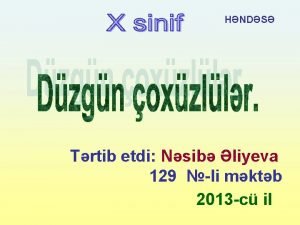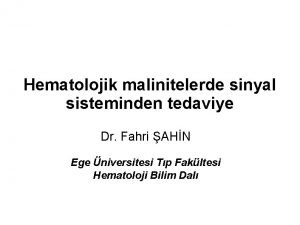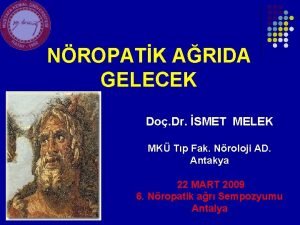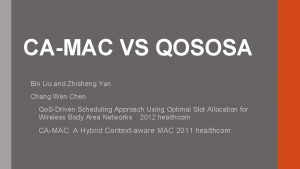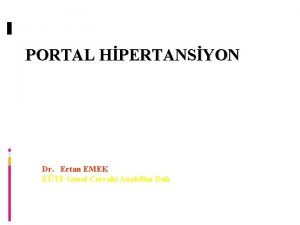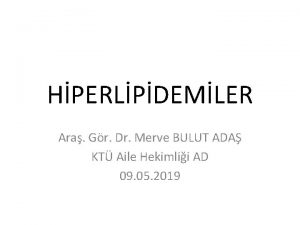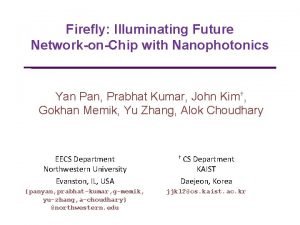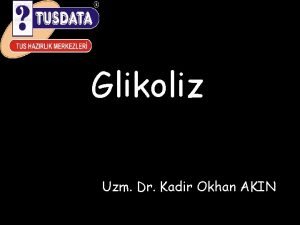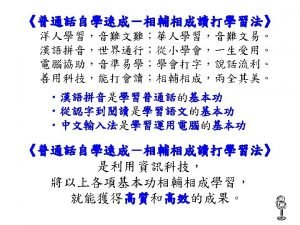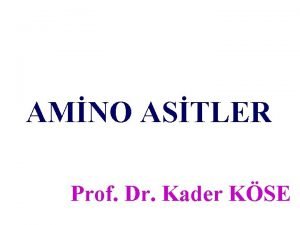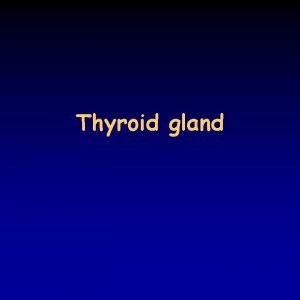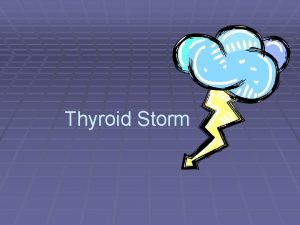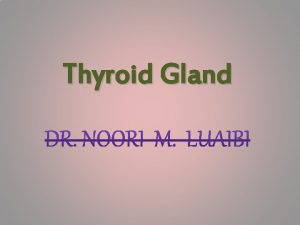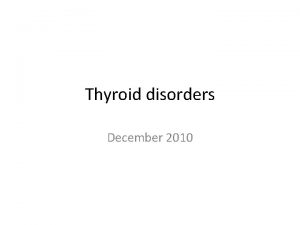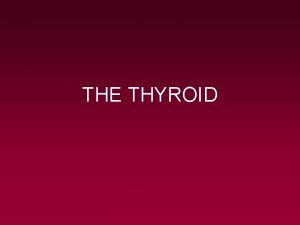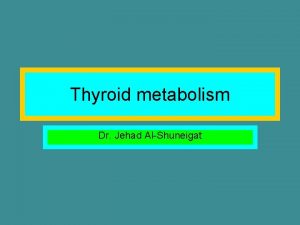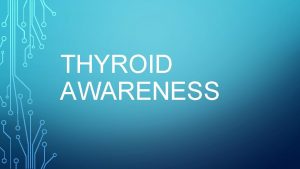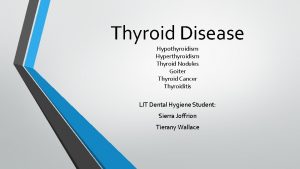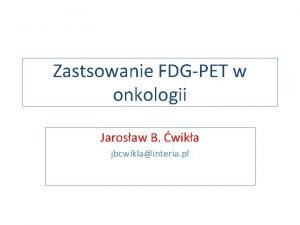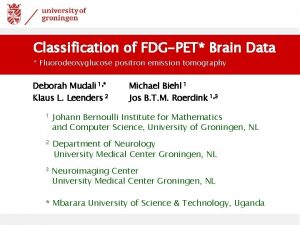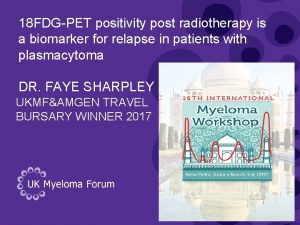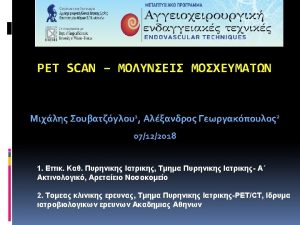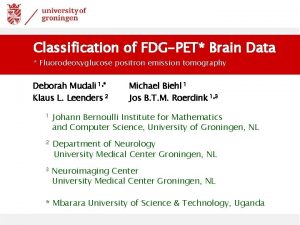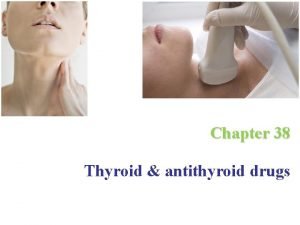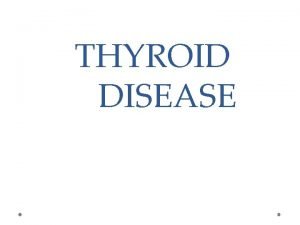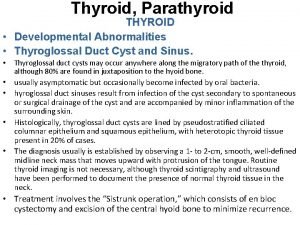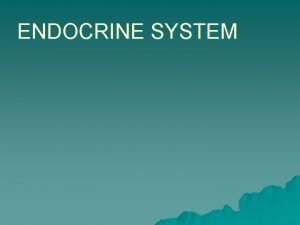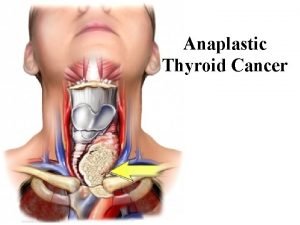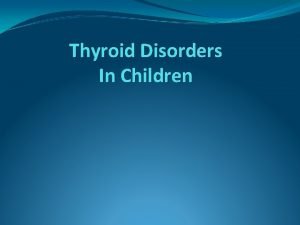FDGPET Detected Thyroid Incidentaloma Dr LP Si Yan


























- Slides: 26

FDG-PET Detected Thyroid Incidentaloma Dr. LP Si Yan Chai Hospital

Background �With the increasing use of imaging modalities, more and more clinically inconspicuous thyroid lesions are discovered �These are termed as thyroid incidentalomas �Also include asymptomatic thyroid lesions identified during non-thyroid neck surgery, eg. parathyroidecotmy, carotid endarterectomy

�Prevalence �USG: 67% �CT / MRI: 16% �Carotid duplex: 9. 4% �FDG-PET: 2 -3% �Increasing use of FDG-PET �Thyroid carcinomas detected by FDG-PET is more aggressive than those detected by other imaging modalities

FDG-PET �Fluorodeoxyglucose positron emission tomography �Mostly commonly used for �Disease staging for patients with known malignancy �Malignancy screening in healthy individuals

�Increase FDG uptake in metabolically active tissue, e. g. malignancy, infection, inflammation, etc �Normal thyroid gland not shown up

FDG-PET detected thyroid incidentalomas �Unsuspected, asymptomatic thyroid lesions discovered on FDG-PET �Prevalence 1. 2 -4. 8% �Increasing incidence but no increase in disease specific mortality �Risk of malignancy � 14 -74% �higher than incidental thyroid nodules found by USG, CT, or MRI

Is the thyroid incidentaloma on FDG-PET benign or malignant?

Pattern of uptake �Focal �Increase in radioactivity concentration compared to that of the thyroid parenchyma �Clearly delineated from the surrounding thyroid gland �Diffuse �Even distribution of FDG in the entire thyroid gland �Radioactivity concentration is higher than that of the surrounding soft tissue

Focal uptake

Diffuse uptake

�Focal uptake of thyroid lesions on PET also known as �PETomas �PET-associated incidental neoplasms (PAINs) �PET detected thyroid incidentalomas (PETI) �Associated with an increased risk of malignancy than diffuse uptake

20 out of 27 patients who underwent operation proved to have thyroid malignancy (74%) Nishimori H et al. Incidental thyroid “PETomas”: clinical significance and novel description of the self-resolving variant of focal FDG-PET thyroid uptake. Can J Surg Vol. 54, No. 2 , April 2011

SUV �Standardized uptake value �Elevated in metabolically active tissue �Controversies about the use of SUV as an adjunct to differentiate between benign or malignant �No cut off value

Katz SC et al. PET-Associated Incidental Neoplasms of the Thyroid. J Am Coll Surg (2008) 259 -264

�SUV correlates with the size of the thyroid incidentaloma in focal uptake �r = 0. 64, p < 0. 05 Nilsson IL et al. Thyroid Incidentaloma Detected by Flurordeoxyglucose Positron Emission Tomography/Computed Tomography: Practical Management Algorithm. World J Surg (2011) 35: 2691 -2697

Risk factors of malignancy �Clinically apparent thyroid nodules are associated with 5% malignant rate �Are et al. showed that risk of malignancy in the presence and absence of palpable thyroid nodule is 24% and 6. 3% respectively (p = 0. 01)

�Focal FDG uptake and unilateral uptake are associated with higher malignancy rate Are C et al. FDG-PET Detected Thyroid Incidentalomas: Need for Further Investigation? Annals of Surgical Oncology (2006) 14(1): 239 -247

FDG-PET detected incidental thyroid carcinomas �Most are papillary thyroid carcinoma (PTC) �Poor prognostic variants are more common �Tall-cell variant papillary thyroid carcinoma (TCVPTC) �Poorly differentiated thyroid carcinoma �As high as 50% �Extra-thyroidal extension is also more common �Higher treatment failure rate �Higher local, regional and distant recurrences �Higher disease-specific mortality

TCVPTC �More aggressive with a worse prognosis when compared to classical PTC (c. PTC) �High rate of extra-thyroidal extension �Up to 90% in one series �Commonly smaller than c. PTC �FNAC is warranted regardless of the size if the lesion is suspicious

Management �Most of the patients already have a primary malignancy → the whole plan of management should depend on the overall prognosis and life expectancy �USG thyroid is necessary for all patient �No evident nodule → follow up �Nodule ≥ 1 cm or < 1 cm with suspicious features → FNAC

�Suspicious sonographic features �Marked hypoechogenicity �Taller than wide �Irregular shape �Ill-defined margin �Punctate calcification �Increase in vascularity

�FNAC (Bethesda System) �Nondiagnostic �Benign �Atypia of undetermined significance (AUS) �Suspicious for follicular neoplasm / follicular neoplasm �Suspicious for malignancy �Malignant

FNAC results Action Non-diagnostic / AUS Repeat FNAC Benign Follow up Suspicious for follicular neoplasm / suspicious for malignancy / malignant Operation

Conclusion �FDG-PET detected thyroid incidentalomas harbour a significant risk of malignancy �Thyroid carcinomas detected on FDG-PET are more aggressive and demonstrate poorer prognosis �They should be investigated by USG +/- FNAC �Definitive management plan depends on the overall prognosis and life expectancy of the patients

References � American Thyroid Association Management Guidelines for Patients with Thyroid Nodules and Differentiated Thyroid Cancer (2009) � Jin J et al. Thyroid incidentaloma. Best Practice & Research Clinical Endocrinology & Metabolism 26 (2012) 83 -96 � Nilsson IL et al. Thyroid Incidentaloma Detected by Flurordeoxyglucose Positron Emission Tomography/Computed Tomography: Practical Management Algorithm. World J Surg (2011) 35: 26912697 � Ho TY et al. Prevalence and significance of thyroid uptake detected by 18 F-FDG PET. Endocrine (2011) 40: 297 -302 � Bertagna F et al. F 18 -PDF_PET/CT thyroid incidentalomas and their benign of malignant nature: a critical and debated issue. Ann Nucl Med (2011) 25: 151 -152 � Nishimori H et al. Incidental thyroid “PETomas”: clinical significance and novel description of the self-resolving variant of focal FDG-PET thyroid uptake. Can J Surg Vol. 54, No. 2 , April 2011 � Law TT et al. Incidental Thyroid Carcinoma by FDG-PET/CT: A Study of Clinicopathological Characteristics. Ann Surg Oncol (2011) 18: 472 -478

� Jin J et al. Incidental thyroid nodule: patterns of diagnosis and rate of malignancy. The American Journal of Surgery (2009) 197, 320 -324 � Kang BJ et al. Incidental thyroid uptake on F-18 FDG PET/CT: correlation with ultrasonography and pathology. Ann Nucl Med (2009) 23: 729 -737 � Gough J et al. Thyroid Incidentaloma: An Evidence-based Assessment of Management Strategy. World J Surg (2008) 32: 1264 -1268 � Katz SC et al. PET-Associated Incidental Neoplasms of the Thyroid. J Am Coll Surg (2008) 259 -264 � Are C et al. Histological Aggressiveness of Fluorodeoxyglucose Positron-Emission Tomogram (FDG-PET)-Detected Incidental Thyroid Carcinomas. Annals of Surgical Oncology (2007) 14(11): 3210 -3215 � Are C et al. FDG-PET Detected Thyroid Incidentalomas: Need for Further Investigation? Annals of Surgical Oncology (2006) 14(1): 239 -247
 Kubun diaqonal kəsiyinin sahəsi
Kubun diaqonal kəsiyinin sahəsi Lioresal etken madde
Lioresal etken madde Houmin yan
Houmin yan Tracutil amp
Tracutil amp Prostat kanseri hormon tedavisi yan etkileri
Prostat kanseri hormon tedavisi yan etkileri Yan gobeil
Yan gobeil Sativex yan etkileri
Sativex yan etkileri Dr chan yan fat alfred
Dr chan yan fat alfred Zhisheng yan
Zhisheng yan Yan chen northwestern
Yan chen northwestern Hepatopedal akım
Hepatopedal akım Altıgen prizmanın yüz sayısı
Altıgen prizmanın yüz sayısı Beslenme epidemiyolojisi
Beslenme epidemiyolojisi Pfizer organizational structure
Pfizer organizational structure Anlam kötüleşmesi örnek
Anlam kötüleşmesi örnek Dr yan pan
Dr yan pan Pirüvat dehidrogenaz aktivatörü
Pirüvat dehidrogenaz aktivatörü Yan chen northwestern
Yan chen northwestern Lee zhong yan
Lee zhong yan Silindrin
Silindrin Yamuk özellikleri
Yamuk özellikleri Huai yan jav
Huai yan jav Yan oi tong tin ka ping secondary school
Yan oi tong tin ka ping secondary school Lizin bazik
Lizin bazik Takyan cheung
Takyan cheung Yan asuncion accident
Yan asuncion accident Lisa yan stanford
Lisa yan stanford
